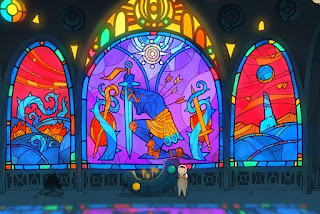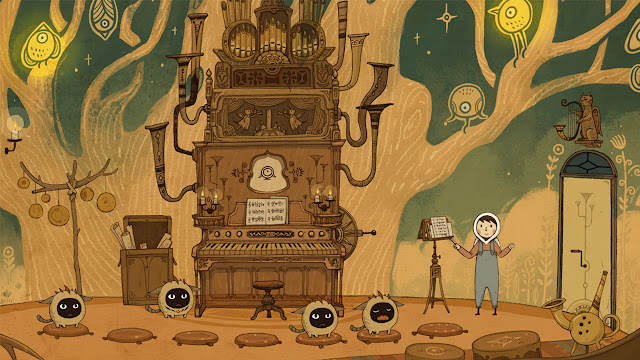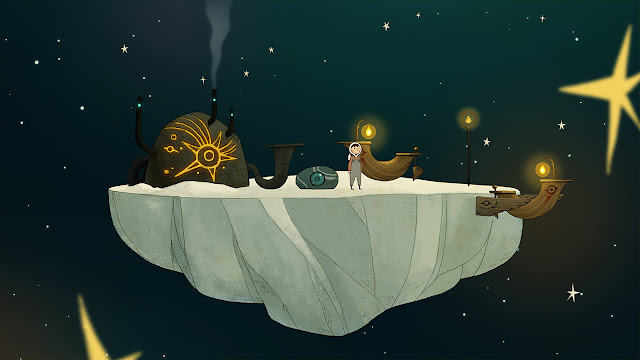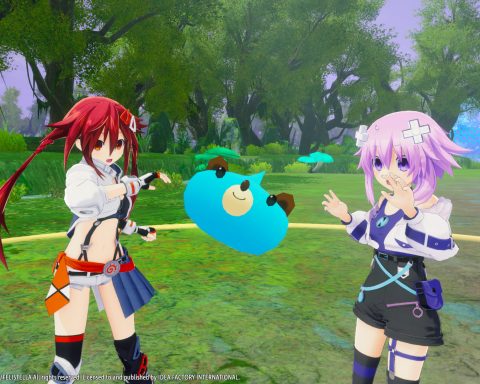LUNA The Shadow Dust bears more than a little similarity to one of my favourite games of all time, Gorogoa. The hand-drawn, colourful art styles and surreal, dreamlike narratives of both games are enchanting and memorable, which is why I thought I’d love LUNA just as much after the first few levels. It’s a point-and-click puzzle game by Lantern Studio and published by China-based Coconut Island Games, also one of my favourite publishers of recent note. Maybe it was my high expectations which LUNA had trouble meeting – because while it’s certainly a competent game, it’s missing the magic which I’d come to love from the adventure games it’s inspired by.
LUNA’s gameplay is simple and easy to understand. Players take the role of Uri, a child with an adorable rabbit-ears hat, and their vaguely feline companion Layh, each with different skills. Uri is a bit better at climbing and can push heavy objects around, while Layh can interact with certain environmental objects by bouncing on them. The puzzles the pair encounter are of the order-of-operations variety, each one can be solved with a little inquisitive exploration of the environment, and some logical thinking.
The game captures the player’s attention with its surreal tone, depicting the pair climbing a strange tower in the middle of nowhere. In each room, the two are faced with a self-enclosed puzzle which will grant them access to a higher floor. The tower’s denizens are strange and wonderous: mice who shapeshift and morph, rooms full of alchemic tools, strange musical instruments, or cartographic equipment. Particularly interesting are the rooms with runes or pictographs, hinting at a deeper history.
Unfortunately, the tone of the game never quite translated to story, and I had a hard time discerning exactly what LUNA was trying to say about its raised themes of mythology, knowledge and creativity. It’s a wordless game, with admittedly gorgeous art, but without a deep sense of character development, progression, relationship or conflict. Instead, the game relies more on symbolic moments of love and separation between Uri and Layh, as well as hinting at deeper significances in the cutscenes between levels. These cutscenes can take the player by surprise, since they’re so elegantly drawn, but due to the traditional nature of the animation, they’re slow-paced, with many still frames. It’s fantastic at communicating mood, but by the end of the game, I wished there was something more thematic to chew on, like what Gorogoa did with its musings on war, aging and rebirth.
The puzzles themselves are more self-enclosed, and are only tenuously linked to the overarching narrative. The surrealism lets the puzzles be an abstraction, without having to worry about feeling like a contrivance. Each room that the player enters will have some kind of theme, and usually, it’s a striking visual style which first draws the eye. The puzzle itself is simple, and I do like how the enclosed puzzle-room design and the limited number of things to interact with (in addition to no inventory system) means that the solution is easily accessible to players of all skill levels. There are a few later puzzles which involved manipulating light, shadow and the environment in creative ways, which I really loved. What I didn’t like however was the way that many puzzles had tedious solutions; oftentimes Uri would need to walk back and forth across the room and hit switches over and over – and this made puzzles cumbersome when players figure out the answer but still need to go through the motions to move on.
The graphics and sound are top-notch, and at times I had wished that LUNA could have taken life as a graphic novel or an animated short film rather than a game. The music is especially evocative and works to great effect to communicate the mood that the developers are going for. It’s just that the narrative doesn’t come together in any spectacular way, and so it remains in my memory as a collection of disparate puzzles and moments. While each one is impressive for its sheer detail and ingenuity, I never got the feeling that the collected whole was made for any prescient meaning.
The porting job to the Switch also leaves a little to be desired; it’s natural that a point-and-click game would feel a little out of place on console, but the lack of touch-screen support is unfortunate. The current system, moving Uri with the joystick and selecting different options by holding down ZL, is a little unintuitive, but functional once the player gets the hang of it. It does admittedly give most of the puzzles away; since the player immediately knows what they can interact with and what is background dressing, it doesn’t take long to figure out what needs to be done in each of the game’s rooms.
For all my disappointments with what LUNA The Shadow Dust could have been, there was a fair share of impressive moments that kept me going. I did want to see what each next puzzle would look and play like, and the mysterious tone did keep me wondering if there was going to be a big payoff at the end. I think that with a proper story, perhaps with some dialogue or written text, LUNA could have been a far stronger game. It feels like the puzzles are the lengthening elements to what could have been an epic narrative. But as it is, LUNA The Shadow Dust is very pretty, plays well, but unfortunately doesn’t do anything meaningful with its high production values.
Contributor
The critic was provided with a copy of this game for review.










